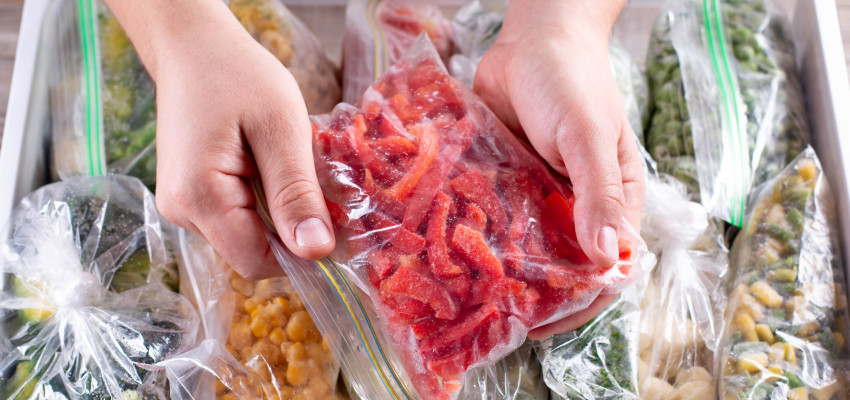By Chef Alli on April 17, 2024
21 Things You Didn't Know You Can Freeze

If you’ve ever thrown out leftover tomato paste or a log of your favorite goat cheese because it went bad before you could finish it, this list is for you.
Below are 21 foods you may (or may not) have considered freezing yourself.
1. Whole tomatoes
It’s important to understand that frozen tomatoes will never be the proper consistency for fresh salads or as toppings, but for any recipe where they will be cooked, they’re darn close to perfect.
One of the best perks for freezing whole tomatoes is how they slip right out of their skins once they thaw. Just pop whole tomatoes into a freezer bag, press out the air and seal tightly.
When a soup or stew recipe calls for tomatoes, you’re ready! And, if you cut frozen tomatoes while they’re still partially frozen, they’re super easy to chop.
2. Whole peppers
Freeze these whole just as you do the tomatoes. Easy-peasy!
If you’re especially partial to jalapeño poppers, know they freeze well, too. I like to freeze my poppers on a baking sheet until they are solid, then I use my vacuum sealer to package them. Because they are already frozen before being vacuum sealed, they package better.
When you’re ready to enjoy some poppers, they can go directly into the air fryer from the freezer. In minutes, they are golden brown and piping hot.
3. Ginger
If you’re standing by the ginger bin in the produce department trying to find the smallest knob of ginger, there are two things you should know.
First, fresh ginger is sold by the pound so it’s completely legal to grab that ginormous hunk and break off a piece.
Secondly, if you’re too scared to break off a piece of ginger, choose the freshest hunk knowing what you don’t immediately use at home you can store in the freezer.
Wrap leftover ginger root tightly in plastic wrap, then pop it into a freezer bag and into the freezer. It will be right there when you need it for your next Asian recipe.
4. Garlic
Garlic cloves and even whole heads of garlic freeze like a champ. You can freeze it any time before it gets soft and dry, but the fresher it is upon freezing, the better quality it will be when you use it.
If you’re freezing whole bulbs, clean any dirt from the bulb, then transfer to a freezer-safe container (or freezer bag) and freeze for up to one year. For the best flavor, use within 5-6 months.
Freezing garlic does change the texture of the garlic a bit, but this also helps it cook faster.
5. Wine
After a day or two, the quality of most wine begins to degrade in flavor.
Fortunately, the spoilage reactions that harm wine slow down as temperatures drop, exactly why freezing works. It's a good way to stop those reactions cold.
Wine freezes at roughly 22 degrees Fahrenheit, depending on the alcohol content; the higher the alcohol, the lower the freezing point.
If you enjoy a good glass of wine but can’t master that entire bottle in a timely manner, it’s good to know you can store it in the freezer. And, yes, as long as the contents of the wine bottle are partially gone, you can freeze the wine right in the bottle!
6. Nuts
Any nuts that are only used occasionally should be stored in the freezer. I like to store mine in quart canning jars so I can easily see what I have on hand.
Because nuts contain a high amount of unsaturated fat, they can go rancid at room temperature within just three months.
I freeze peanuts, walnuts, pecans, cashews, macadamia nuts, hazelnuts, pistachios and almonds with great success and they easily keep up to a year in the freezer. No need to thaw before using, either.
7. Chocolate
Can’t pass up those candy sales right after Easter and Halloween? You’ll be pleased to learn you can freeze it! I also keep all my chocolate chip varieties in the freezer.
Chocolate keeps well in the freezer for up to 18-24 months.
8. Pizza dough
I love to keep at least two to three balls of frozen dough in the freezer at all times.
Whether the pizza dough is store-purchased or homemade, I form it into compact balls, each weighing about a half pound. Wrap each one tightly in plastic wrap, then place into a freezer bag.
To use, remove the dough from the freezer, unwrap, then drop the frozen ball of dough into a bowl of tepid water for 10-15 minutes to thaw and rehydrate.
Remove the dough from the water, then leave the dough on the counter, covered with a lightweight towel for 1-2 hours to finish thawing.
You can also remove the dough from the freezer 24 hours before you want to make pizza, allowing it to thaw in the fridge.
Once the dough has fully thawed, regardless of which method you use, be sure to let the dough rest at room temperature for 2-3 hours so the dough can relax. This step is what makes the dough much easier to work with as you are rolling it out.
9. Tomato paste
Spoon leftover tomato paste out in 1-2 tablespoon blobs on a sheet of parchment paper and freeze it solid. Once frozen, place into a freezer bag and keep them in a corner of your freezer that’s handy.
10. Goat cheese
Goat cheese freezes like a charm. When I find it on sale, I stock up and throw it right into the freezer as soon as I get home! Once thawed, you’ll never ever know it was frozen. The texture doesn’t change one bit.
11. Pesto
When you have a plethora of fresh basil toward the end of summer (before it seeds out) make a big batch of pesto in your food processor.
I like to freeze my pesto in ice cubes trays that have large squares which hold 2-3 tablespoons. When the pesto is frozen, place the cubes into a freezer-safe container.
12. Eggs
You can freeze raw eggs, not in the shell.
You simply crack the eggs into a freezer-safe bowl, gently whisk the yolks and whites together, then freeze.
Don’t whisk vigorously since you don’t want to incorporate air into the eggs; this can cause them to be tough and rubbery in texture when you thaw and cook them later.
Be sure to leave some head space when placing the eggs into the container since the eggs will expand as they freeze.
One whole egg is equivalent to three tablespoons of beaten egg mixture.
13. Butter
If there’s anything that freezes beautifully, it’s butter. I always have loads in my freezer because I love stocking up when I find it on sale.
14. Whipping cream (heavy cream)
There’s little you can do to get whipping cream upset —freezing it is the least of its worries! Thaw in refrigeration, then use as you normally would. Once thawed, frozen whipping cream still works perfectly for making whipped cream.
15. Milk
If you’ve had bad luck freezing milk in the past, you may not have known the secret to success: Frozen milk needs to thaw slowly in the fridge. Once fully thawed, give it a good shake to break up any milk fats that have solidified.
16. Coconut milk
I have a couple recipes I make on a regular basis that only require 2/3 cup of coconut milk. This means I’m always left with a good bit of coconut milk remaining in the can. I finally got smart and began freezing the leftover coconut milk in 2/3 cup portions that I can grab and quickly thaw when I need them.
17. Cooked pasta
While it won’t be as good as freshly cooked pasta, it will maintain its texture as long as the pasta you’re freezing has been cooked just to al dente doneness.
If you freeze the pasta spread out on a cookie sheet, then place the frozen shells (or whichever shape you’re freezing) in 1-2 cup portions and into a quart freezer bag, you find these will thaw and reheat much more quickly than you can cook pasta in boiling water start to finish.
18. Cooked rice
The same story holds true for cooked rice—it freezes and reheats perfectly as long as it’s not overcooked initially.
19. Mashed potatoes and mashed sweet potatoes
Excess mashed potatoes after Thanksgiving? They freeze exceptionally well, especially if your recipe calls for lots of butter and cream. Before freezing, make sure the mashed potatoes are fully cooled. Since I’m usually cooking for six, I freeze my mashed potatoes in 2-3 cup portions. Two bags containing 2-3 cups of mashed potatoes will thaw and reheat more quickly than one large bag containing 5-6 servings.
20. Tortillas
When I make my own tortillas, I freeze them with a parchment sheet between each one in a gallon freezer bag. Store-purchased tortillas should also be placed into freezer bags before being frozen.
Tortillas of any kind (corn or flour) will keep nicely in the freezer for up to six months.
21. Rotisserie chicken carcasses
If you enjoy making homemade chicken broth, remember to toss your leftover chicken carcasses into the freezer. When you’ve accumulated five or six of them, it’s time to grab your largest pot and get busy. Homemade chicken broth is so easy to make, and you can store it in the freezer as well.
You Might Also Enjoy





